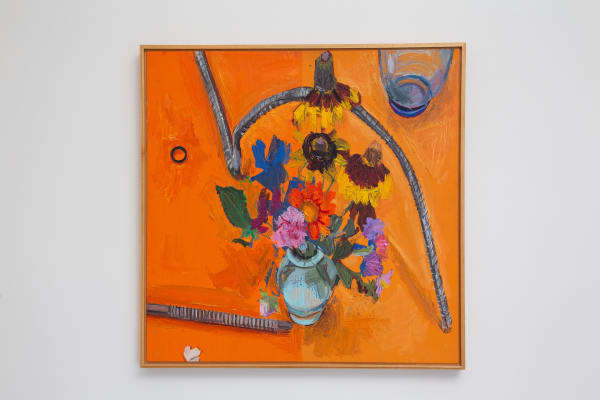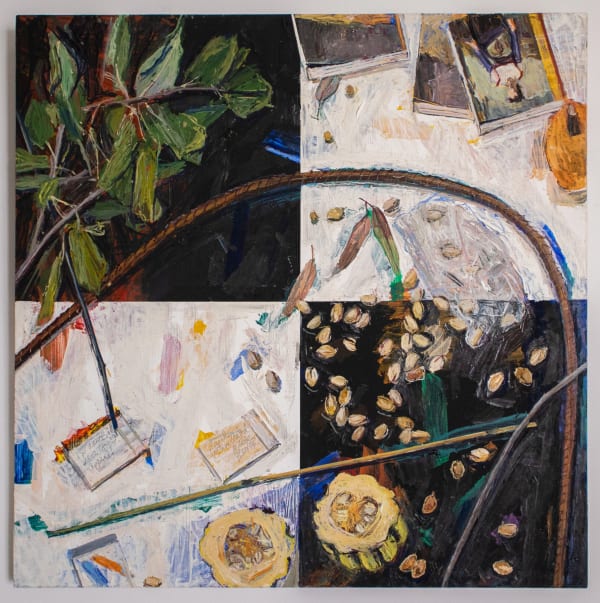Domestic Memory: Manny Farber and Patricia Patterson
Quint Gallery proudly presents Domestic Memory, a two-person exhibition featuring Manny Farber (b. 1917; d. 2008) and Patricia Patterson (b. 1941). Life-long partners and collaborators, the pair are known, both together and in their own right, as painters and critics who became instrumental figures in the San Diego art and academic community since their arrival from New York in 1970. Farber, an established film critic and painter, was invited to teach at the University of California, San Diego in their newly formed Visual Arts department. Patterson was soon asked to teach drawing, and later, graduate seminars on art and politics in utopian communities, the Shakers, de Stijl, and the Russian Constructivists.
This presentation highlights a small selection of Farber and Patterson’s work made between the late 1980’s and early 1990’s, chronicling their interpretations of the everyday and the periodic crossover between their forms, framing devices, and a shared use of color.
Since her early 20s, studying art at Parson’s School of Design in New York, Patterson embarked on the beginning of her enduring relationship with travel, visiting Ireland’s Aran Islands over months and years, living with families and befriending their local community of farmers. She picked up the language and spent her time painting their stone-wall lined landscapes and tenderly tracing the domestic lives of the women, depicting interactions that centered around their brightly decorated and active kitchens.
Manny and Patricia’s interests in painting were bound together by the life they built together in San Diego. There is a weaving in and out of references that connect the pair’s dynamic relationships to artmaking. The domestic, diorama-like scenes in Patterson’s paintings of the people of Aran have often been looked at through comparisons to cinema, like Chantal Akerman’s Jeanne Dielman, 23, quai du Commerce, 1080 Bruxelles, which was the subject of Patterson and Farber’s final film review completed together before their focuses shifted more fully to painting and teaching. With a fixed distance, Patterson’s scene constructions were never invasive nor intruding too closely on her subjects, striking a balance between documentary and abstraction.
Farber, known for his iconoclastic reproaches of the sentimental in cinema, later focused mostly on his tabletop compositions that are in many ways loving collaborations with Patricia; these works are characteristically strewn with leaves and flowers from the garden designed by and tended to by Patricia, which divided their studio spaces. Other objects, like handwritten notes, cutout paper constructions and torn out art book pages, rebar and garden tools deploy paths directing the viewer to work their way through the painting. While Manny’s source material was pulled from the activity of their shared spaces, Patricia pulled from the palette of those Aran households, which often found its way onto the actual walls and trim of their home in Leucadia.
Despite both artists centering horizontality in their work, a sense of timeline is difficult to perceive and their degrees of linearity vary. Patricia’s paintings depicting a culture far flung from Southern California could have been from five or fifty or one hundred years past, later finding ways to connect the two worlds in which she was living. The indoor/outdoor architecture of their home became resonant in their paintings, especially Farber’s. Manny and Patricia spent their years together discovering the nature of things, tending to and crafting their interior and exterior spaces day by day which was ultimately reflected in their bodies of work.
Manny Farber received the National Endowment for the Humanities, Fellowship for Independent Study in 1977-78 and the Guggenheim Fellowship in 1978-79. His work is included in the collections of the Museum of Contemporary Art, Los Angeles, the Solomon R. Guggenheim Museum, New York, the Whitney Museum of American Art, New York; the Museum of Contemporary Art San Diego; and the Museum of Fine Arts, Boston among others. In 2018, MOCA LA organized One Day at a Time: Manny Farber and Termite Art.
Patricia Patterson’s work has been shown in numerous museums including the Los Angeles Contemporary Museum of Art, the Museum of Contemporary Art San Diego, the San Diego Museum of Art, and MOCA Los Angeles. She completed public commissions for INSITE’s 1994 and 1997 editions, and in 2000, completed An Enclosed Garden at the Carlsbad Flower Fields for their Color Project. Patterson lives and paints at her home in Leucadia, CA.










